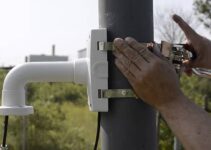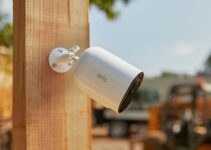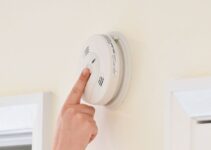First Alert Smoke Alarms are designed to keep you safe by alerting you to potential fires or smoke in your home. However, if your alarm keeps going off without any apparent reason, it can be quite concerning.
In this article, we’ll explore some of the most common causes of a First Alert Smoke Alarm that keeps going off and provide some potential fixes to help you solve the problem.

First Alert Smoke Alarm Keeps Going Off: Likely Causes
Let’s start by discussing some of the possible causes of a First Alert Smoke Alarm that keeps going off.
1. Accumulation of Dust and Dirt
In most cases, you would be dealing with the buildup of dust and dirt inside the device. This is one of the most common reasons for smoke alarm malfunctions. With time, dust and dirt will accumulate on the sensors. When they build up to certain levels, this can cause false alarms. This makes it essential to clean your smoke alarms regularly to ensure they are working correctly.
2. Steam and Humidity
If your smoke alarm is installed in a humid area, such as a bathroom or kitchen, it may be triggered by steam or humidity. To avoid this problem, you can consider installing a smoke alarm specifically designed for use in high-humidity areas.
3. Low Battery
If the battery in your smoke alarm is low, it may start beeping to alert you that it needs to be replaced. Make sure you replace the battery as soon as possible to prevent false alarms.
4. Electrical Issues
Sometimes, faulty wiring or other electrical issues can cause your smoke alarm to go off without any apparent reason. In this case, it’s best to contact a qualified electrician to inspect your wiring and make any necessary repairs.
First Alert Smoke Alarm Keeps Going Off: DIY Fixes
Now that we’ve explored some of the possible causes of a First Alert Smoke Alarm that keeps going off, let’s discuss some of the potential fixes.
1. Clean Your Smoke Alarm
To clean your smoke alarm,
- First, remove it from the ceiling or wall. You can do this by twisting the device counterclockwise until it releases from the mounting bracket.
- Once you have removed the smoke alarm, use a soft-bristled brush or get your vacuum cleaner with a brush attachment to remove any dust or debris. Be sure to clean both the sensors and the outer casing of the device.
- After cleaning the smoke alarm, you can also use a clean, dry cloth to wipe down the outer casing to remove any remaining dust or debris.
- Once you have cleaned the device, reattach it to the mounting bracket by twisting it clockwise until it clicks into place.
- Make sure you clean your smoke alarms regularly, at least once every six months, to avoid this issue.
2. Install a Smoke Alarm for High Humidity Areas
These smoke alarms are typically labeled as “photoelectric” and use a different type of sensor than traditional smoke alarms. Photoelectric smoke alarms are designed to be more resistant to false alarms caused by steam and humidity. They work by detecting the presence of smoke particles in the air using a beam of light. If the beam of light is disrupted, the alarm will be triggered.
When installing a smoke alarm for high-humidity areas, be sure to follow the manufacturer’s instructions carefully. Some smoke alarms may require additional ventilation or installation in a specific location to work correctly.
3. Replace the Battery
According to First Alert, you should be replacing the battery in your smoke alarm at least once a year, even if it hasn’t started beeping yet. A low battery can cause your smoke alarm to malfunction or trigger false alarms, so it’s important to replace the battery as soon as possible.
To replace the battery in your smoke alarm;
- First, remove the device from the mounting bracket by twisting it counterclockwise.
- Then, remove the old battery and replace it with a new one.
- Be sure to use the correct type of battery as indicated in the manufacturer’s instructions.
- Once you have replaced the battery, reattach the smoke alarm to the mounting bracket by twisting it clockwise until it clicks into place.
4. Contact a Qualified Electrician
If you’ve tried all of the above fixes and your smoke alarm still keeps going off, it’s best to contact a qualified electrician to inspect your wiring and make any necessary repairs. Faulty wiring or other electrical issues can cause your smoke alarm to go off without any apparent reason, so it’s important to have a professional assess the situation.
When contacting a qualified electrician, be sure to explain the issue in detail and provide any relevant information about your smoke alarm, such as the make and model number. The electrician may need to inspect your home’s wiring or check for any other issues that could be causing the problem.
In addition to these fixes, there are a few other things you can do to help prevent false alarms from your smoke alarm:
- Keep your smoke alarm away from sources of steam and humidity, such as bathrooms and kitchens.
- Regularly test your smoke alarm to make sure it’s working properly.
- Replace your smoke alarm every 10 years, even if it hasn’t started beeping yet.
Wrapping Up
There are several potential fixes for a First Alert Smoke Alarm that keeps going off, including cleaning the device, installing a smoke alarm for high humidity areas, replacing the battery, and contacting a qualified electrician. It’s important to take these steps to ensure the safety of yourself and anyone else you have in your home.
Hopefully, this guide has helped you understand some of the possible causes of a First Alert Smoke Alarm that keeps going off and provided some potential fixes to help you solve the problem. Remember, if you’re ever in doubt, it’s always best to contact a qualified professional for assistance. Stay safe!





